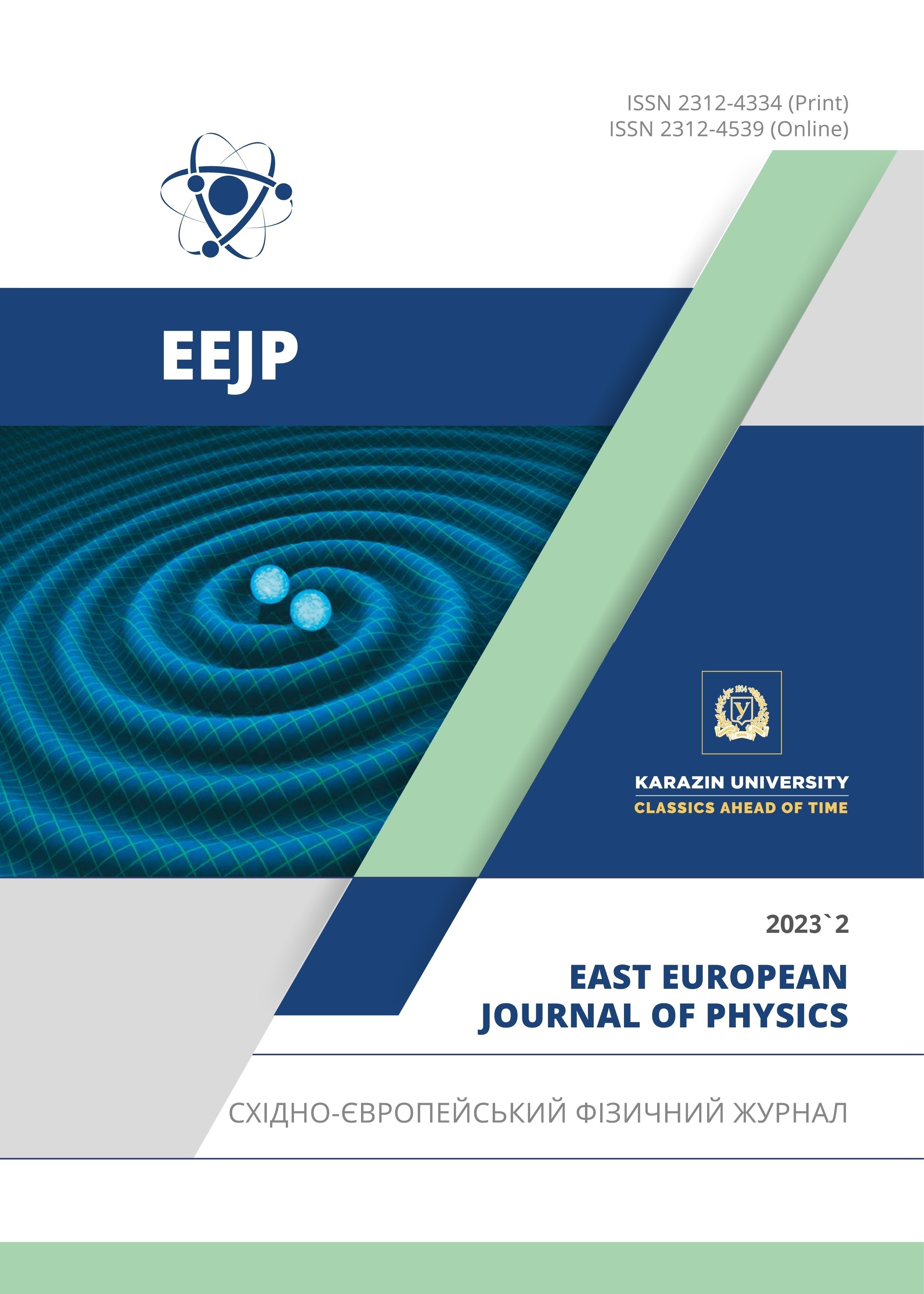Вплив швидкості газу, часу впливу та старіння на фізико-хімічні властивості води, активованої плазмовим струменем тліючого розряду
Анотація
Метою цієї роботи є вивчення того, як плазмовий струмень тліючого розряду змінює хімічні та фізичні властивості води. У цій роботі фізико-хімічні властивості води досліджувалися за допомогою плазмового струменя з газом аргон. У скляну посудину діаметром 5 см і глибиною 1 см налили 10 см3 дистильованої води. Система працювала при змінній напрузі 12 кВ і частоті 20 кГц, а час експозиції становив від 1 до 30 хвилин. Для вимірювання типів активних форм кисню та азоту (RONS), які утворюються використовувалися набори, виготовлені американською компанією Bartvation на швидкостях потоку 0,7, 1,0, 1,5 та 2,1 л/хв. Дані показали, що рівні NO2, NO3 і H2O2 були занадто високими. З часом він стає більшим і швидкість потоку зростає. Рівень pH з часом знижується, поки не досягне 3, а температура підвищується, поки не досягне 33°C. Однак pH підвищується з часом зберігання, і через 24 години вода повертається до свого природного pH 7. Кількість NO2, NO3 у повітрі трохи підвищується, а потім починає швидко знижуватися через 6 годин. Через 24 години концентрація близька до нуля. Звідси зрозуміло, що плазмовий струменевий пристрій тліючого розряду може створювати RONS, які можна використовувати для біологічних цілей.
Завантаження
Посилання
A. Fridman, Plasma Chemistry, (Cambridge University Press, Cambridge, UK, 2008).
M. Domonkos, P. Tichá, J. Trejbal, P. Demo, “Applications of Cold Atmospheric Pressure Plasma Technology in Medicine, Agriculture and Food Industry,” Appl. Sci. 11, 4809 (2021). https://doi.org/10.3390/app11114809
G. Fridman, A. Shereshevsky, M.M. Jost, A.D. Brooks, A. Fridman, A. Gutsol, V. Vasilets, and G. Friedman, “Floating electrode dielectric barrier discharge plasma in air promoting apoptotic behavior in melanoma skin cancer cell lines,” Plasma Chem. Plasma Process, 27(2), 163-176 (2007). https://doi.org/10.1007/s11090-007-9048-4
M. Laroussi, and T. Akan, “Arc‐free atmospheric pressure cold plasma jets: A review,” Plasma Process. Polym. 4(9), 777-788 (2007). https://doi.org/10.1002/ppap.200700066
A. Fridman, A. Chirokov, and A. Gutsol, “Non-thermal atmospheric pressure discharges,” J. Phys. D. Appl. Phys. 38(2), R1 (2005). https://doi.org/10.1088/0022-3727/38/2/R01
T. Royintarat, P. Seesuriyachan, D. Boonyawan, E.H. Choi, and W. Wattanutchariya, “Mechanism and optimization of non-thermal plasma-activated water for bacterial inactivation by underwater plasma jet and delivery of reactive species underwater by cylindrical DBD plasma,” Curr. Appl. Phys. 19(9), 1006-1014 (2019). https://doi.org/10.1016/j.cap.2019.05.020
S.G. Joshi, M. Cooper, A. Yost, M. Paff, U.K. Ercan, G. Fridman, G. Friedman, A. Fridman, A.D. Brooks, “Nonthermal dielectric-barrier discharge plasma-induced inactivation involves oxidative dna damage and membrane lipid peroxidation in Escherichia coli,” Antimicrob. Agents Chemother. 55(3), 1053-1062 (2011). https://doi.org/10.1128/AAC.01002-10
P. Lukes, E. Dolezalova, I. Sisrova, and M. Clupek, “Aqueous-phase chemistry and bactericidal effects from an air discharge plasma in contact with water: evidence for the formation of peroxynitrite through a pseudo-second-order post-discharge reaction of H2O2 and HNO2,” Plasma Sources Sci. Technol. 23(1), 15019 (2014). https://doi.org/10.1088/0963-0252/23/1/015019
N.K. Kaushik, B. Ghimire, Y. Li, M. Adhikari, M. Veerana, N. Kaushik, N. Jha, B. Adhikari, et.al., “Biological and medical applications of plasma-activated media, water and solutions,” Biol. Chem. 400(1), 39 62 (2019). https://doi.org/10.1515/hsz-2018-0226
P. Bruggeman, and C. Leys, “Non-thermal plasmas in and in contact with liquids,” J. Phys. D. Appl. Phys. 42(5), 53001 (2009). https://doi.org/10.1088/0022-3727/42/5/053001
M. Moreau, N. Orange, and M.G.J. Feuilloley, “Non-thermal plasma technologies: new tools for bio-decontamination,” Biotechnol. Adv. 26(6), 610-617 (2008). https://doi.org/10.1016/j.biotechadv.2008.08.001
L. Gan, S. Zhang, D. Poorun, D. Liu, X. Lu, M. He, X. Duan, et al., “Medical applications of nonthermal atmospheric pressure plasma in dermatology,” JDDG J. der Dtsch. Dermatologischen Gesellschaft, 16(1), 7-13 (2018). https://doi.org/10.1111/ddg.13373
M. Keidar, D. Yan, I.I. Beilis, B. Trink, and J.H. Sherman, “Plasmas for treating cancer: Opportunities for adaptive and self-adaptive approaches,” Trends Biotechnol. 36(6), 586-593 (2018). https://doi.org/10.1016/j.tibtech.2017.06.013
C. Hoffmann, C. Berganza, and J. Zhang, “Cold Atmospheric Plasma: methods of production and application in dentistry and oncology,” Med. Gas Res. 3(1), 1-15 (2013). https://doi.org/10.1186%2F2045-9912-3-21
T.A. Hameed, and H.R. Hammoud, “Comparison study of plasma-activated water and plasma jet on Escherichia coli bacteria for disinfection of tooth root canal,” Iraqi Journal of Science, 64(12), (2023).
S. Abdul-Kadhim, and H.R. Hammoud, “Development low Temperature non-thermal atmospheric plasma jet sources for the biological applications,” Iraqi Journal of Science, 64(7), (2023).
I.E. Vlad, C. Martin, A.R. Toth, J. Papp, and S.D. Anghel, “Bacterial inhibition effect of plasma activated water,” Rom. Rep. Phys. 71, 602 (2019).
Y. Li, J. Pan, G. Ye, Q. Zhang, J. Wang, J. Zhang, J. Fang, “In vitro studies of the antimicrobial effect of non‐thermal plasma‐activated water as a novel mouthwash,” Eur. J. Oral Sci. 125(6), 463-470 (2017). https://doi.org/10.1111/eos.12374
R. Zhou et al., “Plasma-activated water: Generation, origin of reactive species and biological applications,” J. Phys. D. Appl. Phys. 53(30), 303001 (2020). https://doi.org/10.1088/1361-6463/ab81cf
T. Abuzairi, S. Ramadhanty, D.F. Puspohadiningrum, A. Ratnasari, N.R. Poespawati, and R.W. Purnamaningsih, “Investigation on physicochemical properties of plasma-activated water for the application of medical device sterilization,” AIP Conference Proceedings, 1933(1), 40017 (2018). https://doi.org/10.1063/1.5023987
R.P. Guragain, H.B. Baniya, B. Shrestha, D.P. Guragain, and D.P. Subedi, “Improvements in germination and growth of sprouts irrigated using plasma activated water (PAW),” Water, 15(4), 744 (2023). https://doi.org/10.3390/w15040744
Авторське право (c) 2023 Фарах А. Найм, Хаммад Р. Хумуд

Цю роботу ліцензовано за Міжнародня ліцензія Creative Commons Attribution 4.0.
Автори, які публікуються у цьому журналі, погоджуються з наступними умовами:
- Автори залишають за собою право на авторство своєї роботи та передають журналу право першої публікації цієї роботи на умовах ліцензії Creative Commons Attribution License, котра дозволяє іншим особам вільно розповсюджувати опубліковану роботу з обов'язковим посиланням на авторів оригінальної роботи та першу публікацію роботи у цьому журналі.
- Автори мають право укладати самостійні додаткові угоди щодо неексклюзивного розповсюдження роботи у тому вигляді, в якому вона була опублікована цим журналом (наприклад, розміщувати роботу в електронному сховищі установи або публікувати у складі монографії), за умови збереження посилання на першу публікацію роботи у цьому журналі.
- Політика журналу дозволяє і заохочує розміщення авторами в мережі Інтернет (наприклад, у сховищах установ або на особистих веб-сайтах) рукопису роботи, як до подання цього рукопису до редакції, так і під час його редакційного опрацювання, оскільки це сприяє виникненню продуктивної наукової дискусії та позитивно позначається на оперативності та динаміці цитування опублікованої роботи (див. The Effect of Open Access).








